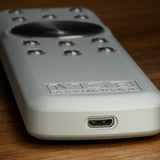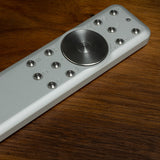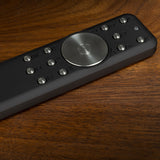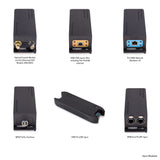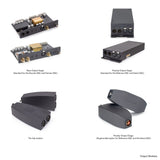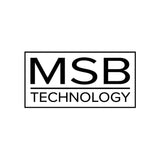MSB
MSB Accessories
When MSB set out to make the MSB remote, the design was built from the ground up. Stainless steel buttons arrayed around an elegant volume wheel to optimize performance and response. California crafted in-house from an aluminium billet, the enclosure feels solid yet refined. Tailored for both the transport and the DAC’s daily use, the remote brings you closer to the music you love.
Input Modules
MSB input modules are a standardised, swappable design that supports all of their DACs. This allows any module to be moved from one DAC to another for seamless upgradeability. Each module uses a tool-less lever lock system for modules that allows simple, quick upgrades and replacements.
Output Modules
The output stage of any DAC can have a large influence on its sound quality. The output stage must translate the signals generated by the D/A circuit into signals compatible with connected amplifiers. This process is ideally without much signal loss, coloration, contamination or degradation. Most D/A circuits have feeble outputs, which must be amplified or buffered in order to successfully navigate the outside world. This amplification or buffering usually results in at least some degradation of sound quality, as the signal is recreated by the active circuitry. This explains why there are thousands of driver circuits to choose from; each one has a different weakness.
MSB Remote
The remote can go months before needing a charge. Simply plug it in and the built-in lithium ion battery recharges within minutes. With four IR emitters and increased battery capacity, signal strength is boosted, emphasising dynamic power in a discrete design.
Features:
- CNC Aluminium Chassis
- Transport controls
- Rechargeable Lithium-Ion Battery
- Ultra powerful IR emitters.
Input Modules
The input interface can have a significant impact on both the sound quality of the DAC, as well as the overall user experience. Input interfaces are constantly changing and are the main reason why digital equipment becomes obsolete. For this reason, MSB made their inputs standardized modules that are user replaceable. In each module, they individually design each interface to perform at its absolute peak performance, with minimum noise, jitter, and maximum isolation. While each interface can transfer data to DAC, each has its own advantages and disadvantages. The primary difference between each interface is they add different amounts of noise and jitter to the audio system. With each interface, MSB's goal is to have perfectly isolated, bit-perfect, low noise and low jitter data transfer.
Optical/Coaxial Module and the Balanced XLR Module (AES/EBU)
These two modules are MSB's S/PDIF interface modules. Around since the eighties, S/PDIF is the universal interface and is sent over optical, coaxial, or differential cabling. This interface is limited in both sample rate, supported data formats, and bit depth. Toslink, Coaxial, and Balanced digital interfaces are most commonly asynchronous unless a separate clock feedback channel is added to the transport or server. In all of MSB's DACs, they provide the best isolation possible the format allows, helping prevent most electrical noise from coupling from the transport.
Advantages:
- Universal across the industry including consumer market
- Toslink is 100% electrical isolated
- Provides an isolated Word Sync output for clock feedback
Limitations:
- Asynchronous (Unless Word Sync is used )
- Isolation (except for Toslink) is limited
- Medium to High jitter
- No error detection or correction
- Limited to 24/192kHz and 1xDSD via DoP
- Limited to short cable lengths without performance degradation.
MSB USB Inputs (Not Including the ProUSB solution)
Standard USB inputs on DACs are common. What isn’t common is what MSB does with theirs. The entire USB module has a high level of isolation between the USB hardware and the DAC. The USB interface is limited to 384kHz and 4xDSD. Our MQA version also supports full MQA decoding.
Advantages:
- Synchronous to the DAC
- Works with most music server and computer systems that support USB audio
- Works at rates up to 24/384kHz and 4xDSD
Limitations:
- Limited level of isolation between the DAC and the often extremely noisy source
- Offers no software control of the DAC from the host source (Volume, etc…)
- Limited to short cable lengths
The MSB Network Renderer V2
There are many renderer interfaces in the industry. MSB designed and developed their own processing card and software with performance and low noise in mind. MSB Renderer V2 interface is MQA and Roon Ready and has a maximum sample rate of 32/768kHz and 4xDSD. The entire renderer solution is galvanically isolated from the DAC, including isolated power. The main advantage of the Renderer Input module is that it turns the DAC into a network endpoint for many current playback software packages and allows computer control of the DAC volume.
Advantages:
- Synchronous to the DAC
- Offers software control of the DAC from the host source (Volume, etc…)
- Works at rates up to 32/768kHz and 4xDSD
- MQA decoding
- Roon endpoint
- Lower noise than most music servers or direct USB connections
Limitations:
- Only provides a medium level of isolation between the DAC and the typically noisy home network
- Prone to network issues
MSB ProISL Interface
This interface is the highest performance digital audio interface. The interface is glass fiber optic based, making it 100% electrically isolated and allowing for incredible cable lengths with no loss. The unique protocol allows a very low jitter copy of the DAC master clock to be fed back to the source, creating a low jitter clock synchronous with the audio data system. The audio data is encoded and sent to the DAC, where it’s checked for errors and corrected before playback. The ProISL is capable of multi-channel audio and extremely high sample rates (much higher than any current standard). Fiber is used because it allows the source and the DAC Any noise generated in the source (CPU, drive, video processing, etc…) can be prevented from entering the DAC and the rest of the audio system.
Advantages:
- Synchronous to the DAC
- Offers 100% electrical isolation between source and DAC
- Interface has strong error detection and correction
- Virtually limitless, lossless cable lengths are supported (up to 1km)
- Source device type and capabilities are reported to the DAC (ProUSB, Transport, Etc…)
- Insensitive to ground and noise issues
- Very low jitter
Limitations:
- Offers no software control of the DAC from the source (Volume, etc…)
MSB ProUSB Input
The ProUSB solution is the ultimate solution for computer audio playback. It provides the ease of a USB interface in conjunction with 100% electrical isolation, long cable lengths, data protection and synchronous interface of the MSB ProISL. By using the ProISL interface, the source can be located physically far away from the system and a single fiber cable can connect to the DAC. The advantage of moving the source far away from the system is much lower electrical noise in your listening room.
Advantages:
- Synchronous to the DAC
- Offers 100% electrical isolation between source and DAC
- Works with most music server and computer systems that support USB audio
- Uses the ProISL interface with error correction and detection
- Virtually limitless in cable lengths (up to 1km) between the USB module and the DAC
- Works at rates up to 24/768kHz and 8xDSD (with a PC)
Limitations:
- Offers no software control of the DAC from the source (Volume, etc…)
MSB Dual ProI2S Input
This is MSB's earlier priority interface. They offer this input for legacy products. This interface uses a completely proprietary electrical interface and has no resemblance to common I2S on the cabling. It provides clock feedback and a medium level of isolation between source and DAC.
Advantages:
- Synchronous to the DAC
- Some level of isolation between the DAC and the source
- Low Jitter
Limitations:
- Only a medium level of isolation between the DAC and the source
- Offers no control of the DAC from the host source (Volume, etc…)
- No error detection or correction
Output Modules
What’s unique about MSB's D/A modules is they create a robust high-power signal that doesn’t need any further amplification or buffering to drive any external load. In all of their DACs, there isn’t active circuitry from the conversion point to the connector on the back. No op-amps, no transistors, no tubes…
MSB's DACs have two basic output types: the “Base Output” and the “Preamp Output”
Base Output Stage (Standard for the Discrete DAC & Premier DAC)
The Base Output stage has two output levels to choose from: high and low. These settings help match the DAC with the amplifier or preamplifier. If a MSB DAC is used directly with an amplifier, an included proprietary ultra-low loss digital volume algorithm is used. Since digital volume control has some loss at lower volume settings, it’s best to match the gain in the system to keep the ideal listening level at a relatively high volume setting. If an external preamp is used, the digital volume control can be completely disabled and bypassed.
Preamp Output Stage (Standard for the Reference DAC & The Select DAC)
When MSB's advanced constant impedance preamp stage is used, the volume level is completely controlled with passive components, without the aid of any digital volume control. The D/A's convert at full level while the preamp stage reduces the output in addition to maintaining a constant output impedance. This technology is utilized without the use of any active circuitry in the DACs output. It’s their philosophy that the best thing you can do to analog audio is nothing. A preamp should be as neutral as possible and should not color the sound in any way. When an MSB Preamp module is used, you get the full quality of the DAC without anything added or removed. The output is pure.
Single-Ended option for Reference DAC & The Select DAC
MSB use external transformers to properly convert a balanced signal to a single-ended output. Transformers can add unwanted magnetic and sonic variations to the sensitive analog components in the output stage of a DAC. Having these transformers in close proximity can also add to unwanted signal cross-talk. This is why they have moved the conversion away from the output stage of the DAC and into a sleek inline unit. Now the signal of your DAC can stay balanced until it is ready to be converted closer to the amplifier and farther from the sensitive analog circuitry of your DAC and preamp.
Analog Expansion Modules
Analog expansion modules are only an option for Preamp output modules that are available for the Select and Reference series. Analog expansion modules allow you to add additional analog inputs and isolated subwoofer outputs.
Additional Analog Inputs (These are available as XLR or RCA specific modules)
They provide an additional XLR/RCA Analog Input. This module is ideal for passing a secondary external analog source through your DAC. The analog inputs allow you to use the volume control of your preamp module to passively attenuate the signal or directly bypass your DACs output circuitry for a simple and unaltered method of adding an additional analog source to your amplifiers. The DAC can support multiple analog input modules.
Isolated Sub-woofer Outputs (These are available as XLR or RCA specific modules)
This module provides a fully isolated XLR/RCA output for use with a powered sub. The Sub Isolator acts as a barrier for the delicate mid to high frequency ranges between your loudspeakers and powered sub.
Only one extra output* option can be used per DAC.
*Isolated Analog Output or Isolated Subwoofer Output
Balance Sub Isolator (XLR)
This unit is made for any DAC or Preamp that has a single balanced output for their main amplifiers and needs a subwoofer output. This module provides a perfectly unmodified pass through, and a fully isolated balanced output for the sub. This is much better than a Y cable.
Single-Ended Sub Isolator (RCA)
This unit is made for any DAC or Preamp that has one single ended output for their main amplifiers and needs a subwoofer output. This module provides a perfectly unmodified pass through, and a fully isolated single ended output for the sub. This is much better than a Y cable.







